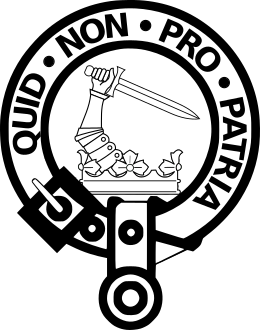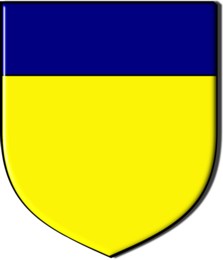Clan Dewar facts for kids
Quick facts for kids Clan Dewar |
|||
|---|---|---|---|
| Deòireach, Mac an Deòir | |||
 |
|||
| Motto | Quid non pro Patria? (Latin) "Why would we not do it for our Country?" |
||
| Slogan | Chiefs heir = Roderick Dewar | ||
| Chief | |||
 |
|||
| Michael Kenneth O’Malley Dewar | |||
| Dewar of that Ilk And Vogri | |||
|
|||
|
|||
Clan Dewar is a Scottish clan. It is an ancient family with a rich history. The clan has roots in the Scottish Borders and the Highlands.
Contents
The Story of Clan Dewar
Where Did Clan Dewar Come From?
Old Stories and Legends
Like many Scottish clans, Clan Dewar has an old legend. This story shows how brave and strong their ancestors were. The legend says a fierce wolf was scaring people near Heriot. A reward was offered to anyone who could defeat the beast. A Dewar is said to have killed the wolf and claimed the reward. We don't know if the Dewar lands were named after the family, or if the family took their name from the land.
Early Written Records
The first official record of the Dewar family is from 1296. Two men, Thomas and Piers de Deware, are listed in the Ragman Rolls. This was a list of Scottish nobles who promised loyalty to Edward I of England.
In 1474, Lord Borthwick gave land in Dewar to William Dewar. This family became known as the Dewars of that Ilk. This means they were named after their land. They became important in the 1500s and 1600s. William Dewar later sold these lands. He moved to nearby Carrington. The main line of the Clan Dewar chiefs comes from this William Dewar.
Clan Dewar in Major Scottish Wars
The name Dewar comes from the Scottish Gaelic word Deoradh. This word means "pilgrim." One important Highland family of Dewars was the Dewar Coigerachs. They were the guardians of the Staff of St Fillan. This special staff was carried into the Battle of Bannockburn in 1314. It was there to support Robert the Bruce against the English. This priceless item from the early Celtic church is now kept in the National Museum of Scotland in Edinburgh.
Clan Life in the 1700s and 1800s
A part of Clan Dewar, the Dewars of Cambuskenneth, started by the 1600s. However, Dewars were recorded in nearby Stirling as early as 1483. Stirling was an important Royal Burgh. In 1710, John Dewar of Cambuskenneth had to pay a fine. He was fined £50 for causing "blood and riot."
The main line of Clan Dewar, the Dewars of that Ilk, became successful business people. In 1719, they bought the large estate of Vogrie near Gorebridge. The family leadership then passed to James Dewar. He was the nephew of William Dewar of that Ilk.
Clan Dewar in the 1800s and 1900s
The Vogrie estates were very busy with industry. A successful coal mine opened there in the mid-1800s. Scotland's first gunpowder factory was also built there. The fifth Laird of Vogrie lived in India. He was a High Court Judge there. He passed away in 1869. His brother, Alexander Dewar, became the sixth Laird of Vogrie. Alexander served in the Bengal cavalry. He built the large Vogrie mansion house. The estate is now smaller, about 250 acres (1.0 km2), down from 2,000 acres.
Kenneth Dewar was an important naval officer. He helped George V, who was the King of the United Kingdom. Kenneth Dewar also commanded a famous ship, HMS Royal Oak (08). The current chiefs of Clan Dewar are related to this Kenneth Dewar.
The Dewar family whisky business grew into a huge Scottish company. This happened thanks to John Dewar. He was given the title Baron Forteviot of Dupplin in 1917. This Dewar family lived at Dupplin Castle. This grand castle was built between 1828 and 1832. It is one of Scotland's most impressive homes.
The Clan Chief Today
The father of the current chief of Clan Dewar was Lt Col. Kenneth Malcolm Joseph Dewar. He was recognized by the Lord Lyon in 1990. The Lord Lyon is the official who deals with Scottish coats of arms and clans. This recognition meant Clan Dewar became an official Scottish clan with a chief. Before that, it was an Armigerous clan, meaning it had a coat of arms but no recognized chief. The current chief is Michael Kenneth O’Malley Dewar Of That Ilk And Vogri.
Other Clan Connections
The name Dewar is also linked to other Scottish clans. It is considered a sept of the Clan Menzies, Clan Buchanan, Clan Arthur, and Clan Macnab. This means that people with the Dewar surname might also be considered part of these other clans.
See also

